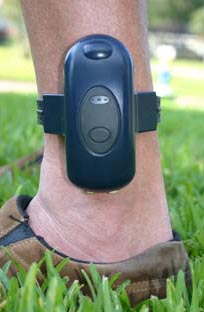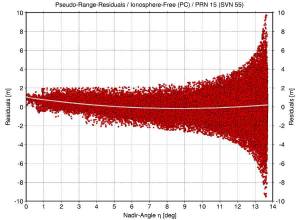 STOP GPS-based monitoring device
STOP GPS-based monitoring device(Updated May 22) Amid a growing controversy over GNSS-aided tracking of private citizens, a recent study sponsored by the U.S. Department of Justice (DoJ) may point toward a politically acceptable, large — and largely untapped — market: monitoring criminals released early from prison.
(Updated May 22) Amid a growing controversy over GNSS-aided tracking of private citizens, a recent study sponsored by the U.S. Department of Justice (DoJ) may point toward a politically acceptable, large — and largely untapped — market: monitoring criminals released early from prison.
According to the study released earlier this week and authored by Stephen Gies and colleagues at Development Services Group, Inc., offenders in a group of California parolees monitored with the aid of GPS demonstrated significantly better outcomes than those who were monitored in traditional ways. Moreover, the technique gained strong support from the parole officers responsible for checking up on the parolees.
The 6,600 high-risk sex offenders (HRSOs) being monitored by the California Division of Adult Parole Operations (DAPO), however, is only a fraction of the state’s more than 100,000 parolees. And nationally, the number of adults under community supervision in 2010 was 4,887,900, according to the DoJ’s Bureau of Justice Statistics. Approximately 100,000 offenders were on any forms of electronic monitoring in 2006, the most recent statistic cited by the report.
Despite the increasing number of HRSOs who are being placed on electronic monitoring programs, the report’s authors pointed out that little is known about how effective these programs are in increasing offender compliance and in reducing recidivism.
The Justice Department’s National Institute of Justice (NIJ) sponsored the study, “Monitoring High-Risk Sex Offenders with GPS Technology: An Evaluation of the California Supervision Program,” which was completed in April.
The study found that GPS-aided monitoring costs more than traditional supervision. However, based on a set of research metrics — outcomes, cost, and process evaluations — the results for GPS-based monitoring were significantly better.
The study population was drawn from all HRSOs — 516 subjects equally divided between the treatment and control groups — who were released from prison between January 2006 and March 2009 and continued to reside in the state of California. Participants in the control group were not placed in the GPS program during the study period.
The subjects in the GPS group demonstrate significantly better outcomes for both compliance and recidivism. Non-compliance (violations of parole) was nearly three times as high for subjects who received traditional parole supervision as for those who received the GPS supervision.
In terms of recidivism — including re-arrest, reconviction, and/or return to prison, the hazard ratio for any arrest was more than twice as high among the subjects who received traditional parole supervision.
The evaluation showed that risk for a sex-related violation was nearly three times greater for offenders who received traditional parole supervision, than offenders who received GPS supervision. The risk of committing an offense that resulted in an arrest was twice as high for offenders who received traditional parole supervision than for offenders in the GPS group.
The cost analysis indicated that the GPS program costs roughly $35.96 per day per parolee, while that of traditional supervision was $27.45 per day— a difference of $8.51 mostly due to equipment costs.
However, the results favored the GPS group in terms of both noncompliance and recidivism. In other words, the GPS monitoring program was more expensive, but also more effective.
Moreover, even the higher GPS-based monitoring costs compare favorably with those of imprisonment. In 2008–09 it cost an average of about $47,000 per prisoner per year to incarcerate an inmate in California, which translates into about $129 per day.
Backed by Parole Officers
The report’s authors said that the GPS-based approach gained “overwhelming positive support” among the DAPO agents responsible for monitoring the parolees — a key group in efforts to expand the use of such systems.
More than 80 percent of the agents who responded agreed or strongly agreed that the GPS monitoring system is a reliable tracking tool, and more than 90 percent felt that GPS enhanced traditional parole supervision. (See accompanying graph.)
Moreover, more than 75 percent felt that GPS supervision provided more public safety than traditional parole supervision, despite the fact that most agents agreed that GPS monitoring is more time intensive than traditional supervision.
According to the most recent Interstate Commission on Adult Offender Supervision (ICAOS 2006) GPS Government Survey, 23 states currently have some sort of GPS monitoring program for sex offenders. Some states (such as California, Colorado, Florida, and Missouri) have enacted legislation requiring the lifetime monitoring of sex offenders.
California’s law came on the books in 2006 when voters passed Proposition 83, commonly referred to as Jessica’s Law. The legislation was named after Jessica Lunsford, a nine-year-old girl who was the victim of a convicted sex offender who had failed to report his whereabouts, in spite of laws requiring him to do so.
The law’s most significant provisions prohibit sex offenders from living within 2,000 feet of any school and park, and mandate GPS supervision for life.
According to the California Department of Corrections and Rehabilitation (CDCR), the state has the highest population of sex offenders in the nation, as well as the largest number of sex offenders equipped with GPS-based monitoring systems — more than 6,600. Of the almost 92,000 sex offenders statewide, CDCR is only responsible for a little more than 11 percent (10,781).
The California GPS monitoring program currently employs tracking systems from two different vendors: Satellite Tracking of People (STOP) LLC, Houston, Texas headquarters and Florida-based 3M Electronic Monitoring (formerly Pro Tech, acquired by 3M in 2010).
The software system of each vendor employs a combination of data integration, geographic information system (GIS), wireless communications, and GPS technology to monitor parolees. Each vendor tracks the information about parolee activities supplied by the GPS technology and transmits it to the supervising parole agent through the vendors’ monitoring centers.
An offender wears a tamper-resistant bracelet that receives GPS satellite signals and calculates the offender’s location. With a passive GPS system, this information is stored and transmitted at appointed times to the monitoring station. With the active GPS system, information on the individual’s location is transmitted to the monitoring station in near “real time.” This allows the monitoring center to alert the probation officer immediately when a violation occurs.
With the GIS, the monitoring system establishes inclusion and exclusion zones, with violations detected by the real-time GPS positioning. An inclusion zone is a geographic area that an offender is required to occupy during certain times of the day. The exclusion zone is an area that the offender is prohibited from entering ever or during certain times of the day.
The monitoring center provides the agent with information in two basic forms: daily reports and immediate alert notification. Almost all agents (91 percent) reported that they responded to exclusion zone alerts within 30 minutes.
The system also provides tools and procedures for analyzing an offender’s movements on a map as well as the capability to correlate crime incident data with GPS tracks to determine whether an offender was in the vicinity of a crime.
Annual cost of the California HRSO GPS-based monitoring program is more than $88 million.





